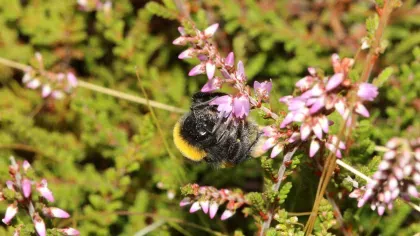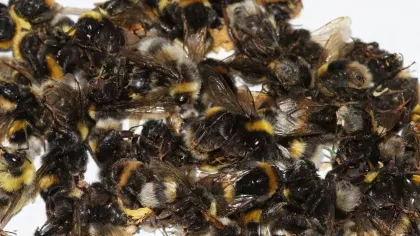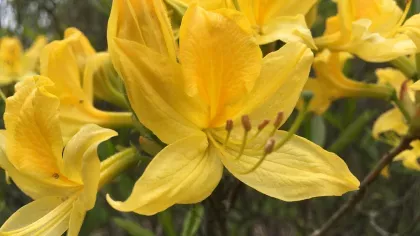6 May 2022
Trees for healthy bees
Certain plant species could improve the health of our vital pollinators.

Many bee species are declining due to climate change, habitat loss and agricultural intensification, so finding ways to conserve our pollinators has never been so important.
Bees are also under threat from natural processes, such as diseases and parasites, that directly affect pollinator health or exacerbate the impacts of other stressors such as pesticides.
These natural processes require greater research attention to help understand their effects on pollinators. Some, such as naturally occurring nectar and pollen compounds, and beneficial gut microorganisms, may even provide solutions to the deteriorating outlook for pollinators.
At Kew, we are undertaking an in-depth study of the chemistry of nectar and pollen in a wide range of plants to identify species that can improve pollinator health.
We are particularly interested in the nectar or pollen that contains “medicinal” compounds that could prevent diseases in bees or enable them to manage excessive impacts of disease.
In our latest study, we have identified compounds in linden (lime; Tilia species) and strawberry trees (Arbutus unedo) nectar that could protect bees from parasite infections.

Parasites and the bee gut microbiome
There are many different bee parasites ranging from viruses to microscopic worms. Some can spread through global trade routes, and spill over from managed honeybee colonies to our wild pollinators, presenting challenges across multiple species.
One important example is Crithidia bombi, a microscopic parasite of bumble bees that attaches to the wall of the bumblebee’s hindgut. Infected bumblebees often fail to start new colonies and can even die early. Since Crithidia is also one of the most widely occurring parasites in bumble bees it is an important research target.
On the other hand, bees also harbour communities of bacteria in their gut (the gut microbiome or microbiota) that can be beneficial for them, for example by protecting against parasitic infections, or processing difficult to digest food components.


Medicinal plants for bees
Previously we reported a naturally occurring chemical in heather (Calluna vulgaris) nectar named callunene that can prevent Crithidia infections in bumble bees.
Our newest research has identified two more nectar compounds, unedone from strawberry trees and tiliaside from linden trees that may help bees to cope with the burden of disease.
Strawberry trees are evergreen shrubs native to Ireland, Western Europe and the Mediterranean, and commonly planted in parks and gardens in the UK.
Its nectar and pollen-rich flowers are known to be an important food for bumblebees in the autumn. Honeybees produce an unusual bitter-tasting honey from the strawberry tree that is a popular folk medicine in the Mediterranean. This bitterness is caused by unedone.
We fed unedone and tiliaside to buff-tailed bumblebees (Bombus terrestris) to test their effects against parasites. Both compounds inhibited Crithidia in our experimental bumblebees.
Interestingly, when we looked in detail at the fate of the two compounds while passing through the bumblebee gut we saw that they were chemically modified to a biologically active form during passage to the parasite infection site in the hindgut.
We found that compounds were “activated” by the beneficial gut microbiome) of the bumblebee for unedone, and from the gut digestive processeson of the bumblebee itself for tiliaside.
Thus, the modification of nectar compounds by the bumblebee or its microbiome are a crucial influence on in whether these compounds have “medicinal” activity in the bee or not.
This work was published in a special issue of the Philosophical Transactions of the Royal Society B dedicated to highlighting the natural processes affecting pollinator health.

Trees for bees and humans
The benefits of planting trees to mitigate climate change, improve our wellbeing and support pollinator biodiversity both in cities and the wider countryside are increasingly recognised.
We have shown that linden and strawberry trees can help bumblebees against one of their common parasites, but also that this interaction is complex and dependent on the processing of the nectar compounds by the bumblebee or its microbiome.
This is especially important new information about the benefits of lime trees (Tilia), which some consider a problem for bees owing to the small numbers of bumble bees found dead underneath them in mid-summer. In contrast to this perceived danger, we show that lime trees provide health benefits to bumble bees.
Planting the correct tree species could therefore not only help feed our pollinators, but also reduce their disease burden. We continue to study the value of trees for pollinators at Kew and within the Landscape Ecology Programme at Wakehurst.
Read the special issue
In this special issue of Philosophical Transactions of the Royal Society B, 20 articles of primary research and critical review examine how natural processes influence pollinator health, from community to individuals, and highlight where some of these processes could mitigate the challenges of anthropogenic and natural drivers of change.
Acknowledgements
We thank the Peter Sowerby Foundation for funding our research.

Many thanks to the team involved:
- Former student interns at Kew: Vita Welcome, Amy Kendal-Smith and Lucy Thursfield
- Prof. Mark Brown, Royal Holloway University of London
- Dr Moses Langat
- Dr Iain Farrell




